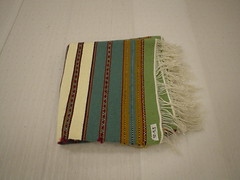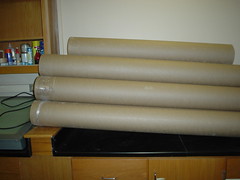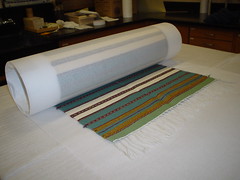More specifically, it's a small woven rug from Iran and it is the first textile in our collection to be rolled.
Yep. Rolled. Rolling is standard practice for storing museum textiles. Folding rugs, blankets, etc. like you might do to store them in your linen closet is not good for long term preservation. The fibers along the fold become brittle and it becomes difficult for the textile to be laid flat. Small textiles can be stored flat, but when it comes to a blanket or a quilt, most museums simply don't have the space to do so.
The rug in question has been folded, probably for several years.

These are the rolls that our textiles are going to be rolled around.

Yes, they look like giant paper towel tubes. And, in essence, they are. Except they are acid-free and unbuffered, which makes them more expensive than giant paper towel tubes. The first step involved wrapping the tube in Tyvek. Even though the tubes are "museum quality" they'd been shipped unwrapped and moved around in that state, so I wanted to provide a definite layer between the textile and the tube.
Then I unfolded the rug and laid it on a long piece of acid-free, unbuffered tissue paper. I carefully, tediously, made sure all the fringe was laying straight:

Since the rolling will have the textile resting against itself for a long long time (unless we use it for an exhibit, or it is the subject of research), any bent fringe, any folds in the textile will be reinforced over time, putting extra stress on the fibers - the exact thing we are trying to avoid. In the same vein as having all the fringe straight, it's important not to let the roll drift, and to make sure the edges of the rolled textile are stacked exactly:

In the above photo you can see how ingrained the creases are already. The tube, prepped with tyvek, is placed in line with the textile. Then we're ready to roll!
Halfway rolled:

To get to the halfway rolled point, I had to start rolling a half dozen times, each time adjusting slightly to make sure the edges of the textile stacked exactly.
All the way rolled:

The textile is entirely rolled, with an outer covering of tyvek to protect it from dust, and a couple of cotton twill tape ties, along with a very important label to let folks know exactly what is inside this mysterious roll.
CWU's Collections Management and Curation course is working with our collection of Navajo textiles this quarter, part of which will require them to roll or otherwise properly store the textile they are working with. So, in the near future, an important portion of our textile collection will be stored this way.
In the words of Optimus Prime: Roll out!
No comments:
Post a Comment